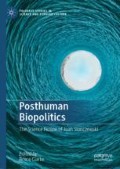Abstract
Sherryl Vint focuses on the representation of microbial life in three Slonczewski novels. Issues of cohabitation across different species culminate in The Highest Frontier with a vision of the possibility of political relations with Ultraphytes, an invasive extraterrestrial species of macro-sized microbial cultures. Drawing on Anna Tsing’s The Mushroom at the End of the World, which considers prospects for cohabitation and collaborative survival in the ruins wrought by capitalist modernity, Vint explores political shifts needed to create a more sustainable culture in the face of species extinctions and global warming. She analyzes how Slonczewski’s depictions of symbioses among possible life forms offer new models for theorizing posthuman subjectivity and sustainable futures.
Access this chapter
Tax calculation will be finalised at checkout
Purchases are for personal use only
References
Braidotti, Rosi. 2013. The Posthuman. Cambridge: Polity.
Clarke, Bruce. 2017. Planetary Immunity: Biopolitics, Gaia Theory, the Holobiont, and the Systems Counterculture. General Ecology: The New Ecological Paradigm, ed. Erich Hörl with James Burton, 193–215. London: Bloomsbury.
Czárán, T., and R.F. Hoekstra. 2009. Microbial Communication, Cooperation and Cheating: Quorum Sensing Drives the Evolution of Cooperation in Bacteria. Public Library of Science One 4 (8). Online.
Diggle, Stephen P., Andy Gardner, Stuart A. West, and Ashleigh S. Griffin. 2007. Evolutionary Theory of Bacteria Quorum Sensing: When Is a Signal Not a Signal? Philosophical Transactions of the Royal Society of London Series B Biological Sciences 362 (1483) (July 29): 1241–49.
Foucault, Michel. 1978. The History of Sexuality. Volume 1: An Introduction. New York: Vintage.
Haraway, Donna J. 1991. “A Cyborg Manifesto: Science, Technology, and Socialist-Feminism in the Late Twentieth Century.” Simians, Cyborgs, and Women: The Reinvention of Nature, 149–81. New York: Routledge.
———. 2007. When Species Meet. Minneapolis: University of Minnesota Press.
Hird, Myra J. 2009. The Origins of Sociable Life: Evolution After Science Studies. Houndmills, Basingstoke: Palgrave Macmillan.
Landecker, Hannah. 2016. Antibiotic Resistance and the Biology of History. Body and Society 22 (4): 19–52.
Latour, Bruno. 1993. The Pasteurization of France, trans. Alan Sheridan and John Law. Harvard: Harvard University Press.
Paxson, Heather. 2008. Post-Pasteurian Cultures: The Microbiopolitics of Raw-Milk Cheese in the United States. Cultural Anthropology 23 (1): 15–47.
———. 2014. Interlude: Microbiopolitics. In The Multispecies Salon, ed. Eben Kirksey. Duke: Duke University Press. Kindle.
Shapiro, James A. 2015. Bringing Cell Action into Evolution. In Earth, Life, and System: Evolution and Ecology on a Gaian Planet, ed. Bruce Clarke, 175–202. New York: Fordham University Press.
Slonczewski, Joan. 1998. The Children Star. Rockville, MD: Phoenix Pick, 2010.
———. 2000. Brain Plague. Rockville, MD: Phoenix Pick, 2010.
———. 2011. The Highest Frontier. New York: TOR.
Tsing, Anna. 2012. Unruly Edges: Mushrooms as Companion Species. Environmental Humanities 1: 141–54.
———. 2015. The Mushroom at the End of the World: On the Possibility of Life in Capitalist Ruins. Princeton: Princeton University Press.
Wolfe, Cary. 2009. What Is Posthumanism? Minneapolis: University of Minnesota Press.
Author information
Authors and Affiliations
Editor information
Editors and Affiliations
Rights and permissions
Copyright information
© 2020 The Author(s)
About this chapter
Cite this chapter
Vint, S. (2020). Microbial Life and Posthuman Ethics from The Children Star to The Highest Frontier. In: Clarke, B. (eds) Posthuman Biopolitics. Palgrave Studies in Science and Popular Culture. Palgrave Macmillan, Cham. https://doi.org/10.1007/978-3-030-36486-1_6
Download citation
DOI: https://doi.org/10.1007/978-3-030-36486-1_6
Published:
Publisher Name: Palgrave Macmillan, Cham
Print ISBN: 978-3-030-36485-4
Online ISBN: 978-3-030-36486-1
eBook Packages: Literature, Cultural and Media StudiesLiterature, Cultural and Media Studies (R0)

